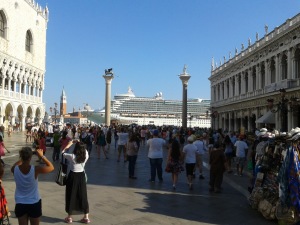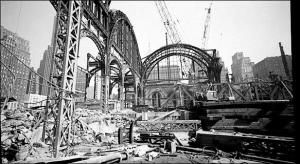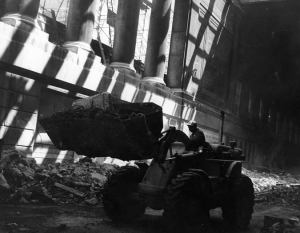Stemming the Loss of Heritage and/or Sparing the Environment. What’s Embodied Energy Got to Do With It?


Background–
The other Saturday I was in NYC attending a day-long symposium celebrating the 50th anniversary of the Historic Preservation program’s founding in the Graduate School of Architecture at Columbia. A good share of the program assumed the climate-preserving virtue of embodied energy, one of several virtues related to embodied energy (which I’ll get to in a minute).
The lead-off speaker was Tim McClimon, President of NYC-based American Express Foundation, who spoke about his company’s partnership with the National Trust for Historic Preservation and the World Monuments Fund. He sketched involvement the foundation is eyeing where preservation and sustainability will be joined programmatically. BTW, American Express tracks annually its carbon footprint from worldwide operations, and, as of last year, 29% of all its electricity comes from wind power, making a serious dent in greenhouse gas emissions.
 Another was Italian Ilaria Cavaggioni, Architect Director of Architectural and Landscape Heritage of Venice and Lagoon. She described a double-risk for heritage: material loss and authenticity loss. In the face of cruise ships docked, towering (some 17-stories in height) over the Piazza San Marco, and disgourging thousands of tourists into Venice for snapshot visits over several hours, she warned that the economic resources for conservation are more limited today.
Another was Italian Ilaria Cavaggioni, Architect Director of Architectural and Landscape Heritage of Venice and Lagoon. She described a double-risk for heritage: material loss and authenticity loss. In the face of cruise ships docked, towering (some 17-stories in height) over the Piazza San Marco, and disgourging thousands of tourists into Venice for snapshot visits over several hours, she warned that the economic resources for conservation are more limited today.
Appealing for his deft touches of humor, MIT Professor John Ochsendorf made claim that preservation straddles the “two cultures” of the sciences and the humanities. “Engineering requirements can be the greatest threat as well as the clearest opportunity for sound stewardship of cultural aspects of the built environment.”
What is Embodied Energy?

 Preservation by its course champions the saving of embodied energy. Here are 3 images of the original Penn Station in NYC on the
Preservation by its course champions the saving of embodied energy. Here are 3 images of the original Penn Station in NYC on the  wrong side of the wrecking ball; a substantial amount of embodied energy wasted by failed railroad management. (My 11/6/13 post showed the historic station in its magnificence.)
wrong side of the wrecking ball; a substantial amount of embodied energy wasted by failed railroad management. (My 11/6/13 post showed the historic station in its magnificence.)
“Because historic preservation essentially involves the conservation of energy and natural resources it is really the greenest of the building arts. And in this day and age, preserving and recycling buildings can play a vital role overcoming what may be the greatest crisis and challenge of our time: climate change.” So writes former National Trust for Historic Preservation President Dick Moe in 2008.
The LEED 3rd-party rating system that I’ve written about extensively (LEED v3) has in its Materials & Resources category two credits pertaining to building reuse. An historic or other older building can earn up to 4 credit points for its major renovation when preserving a high percentage of exterior and interior non-structural elements. The newest version of the rating system, LEED v4, provides an uncomplicated credit awarding 5 points for any national or state historic register listed property. And, same for renovation of an abandoned or blighted building.
Going on in his essay, Moe says:
“Buildings are vast repositories of energy. It takes energy to manufacture or extract building materials, more energy to transport them to a construction site, still more energy to assemble them into a building. All of that energy is embodied in the finished structure, and if the structure is demolished and landfilled the energy locked up in it is totally wasted. What’s more, demolition uses still more energy, and, of course, the construction of a new building in its place uses even more.
“The use of all of that energy releases tremendous amounts of carbon into the atmosphere. For example, it is estimated that building a new 50,000-square-foot commercial building releases about the same amount of carbon into the atmosphere as driving a car 2.8 million miles.

“Don’t assume that the energy efficient operations of that new green building will offset the environmental costs associated with demolishing and replacing an existing building. A recent study from the United Kingdom finds that it can take between 35-50 years for a new, energy efficient home to recover the carbon expended during the construction of the house.
“Also, don’t assume that historic buildings aren’t energy efficient. Many have thick walls and other features that enhance efficiency.”
The kicker: “Their durability allows for renewal that underscores recognizing them as genuinely sustainable resources, and sustainability, after all, is the ultimate objective of a nation and a society that values its future.”
BTW, the LEED certification process has the landmark Empire State Building projected to save over 100,000 metric tons of CO2 over 15 years and reducing potable water consumption by 30%. It’s achieved an EnergyStar rating of 89. Very impressive for an 83-year-long symbol of NYC’s skyline!